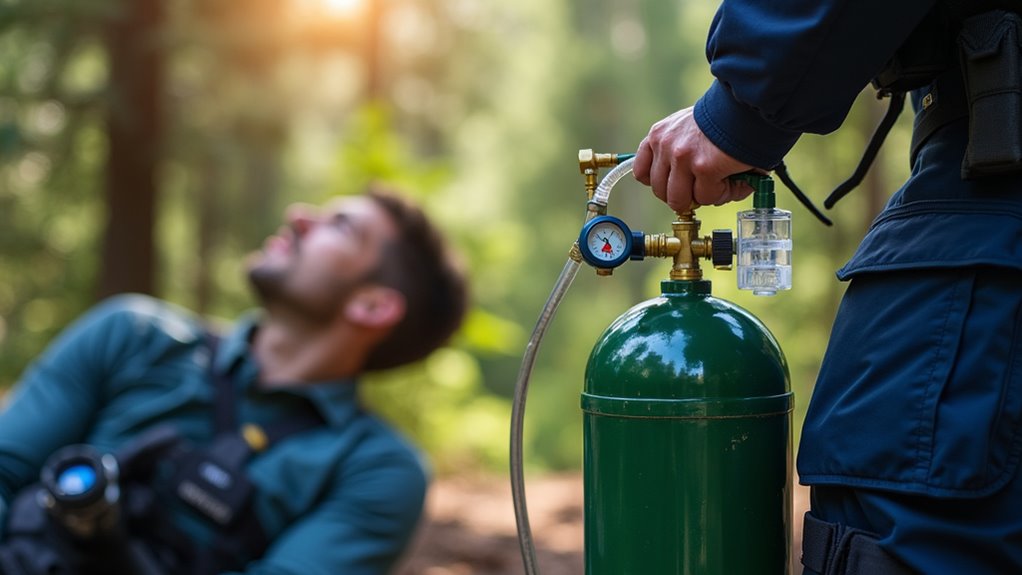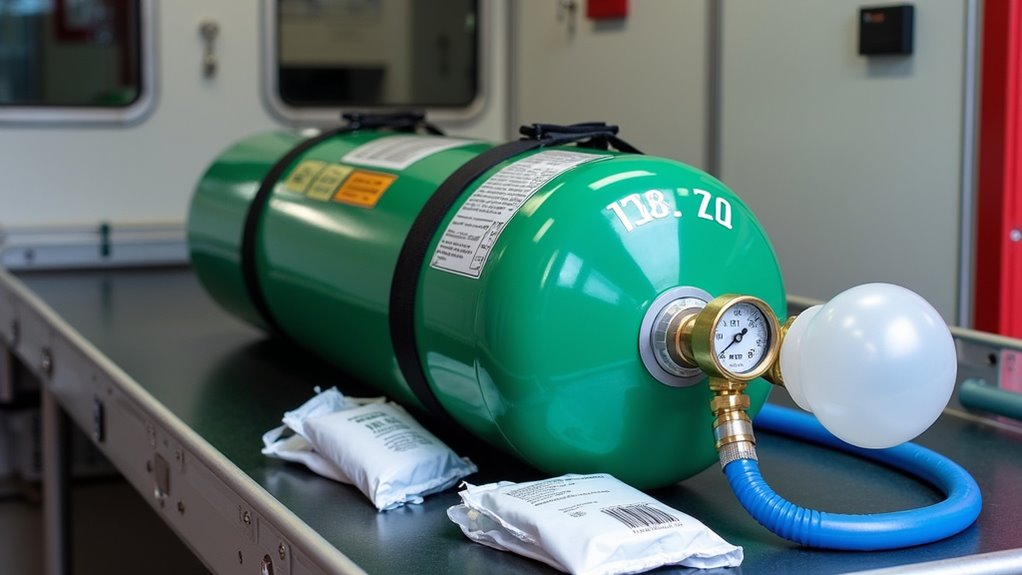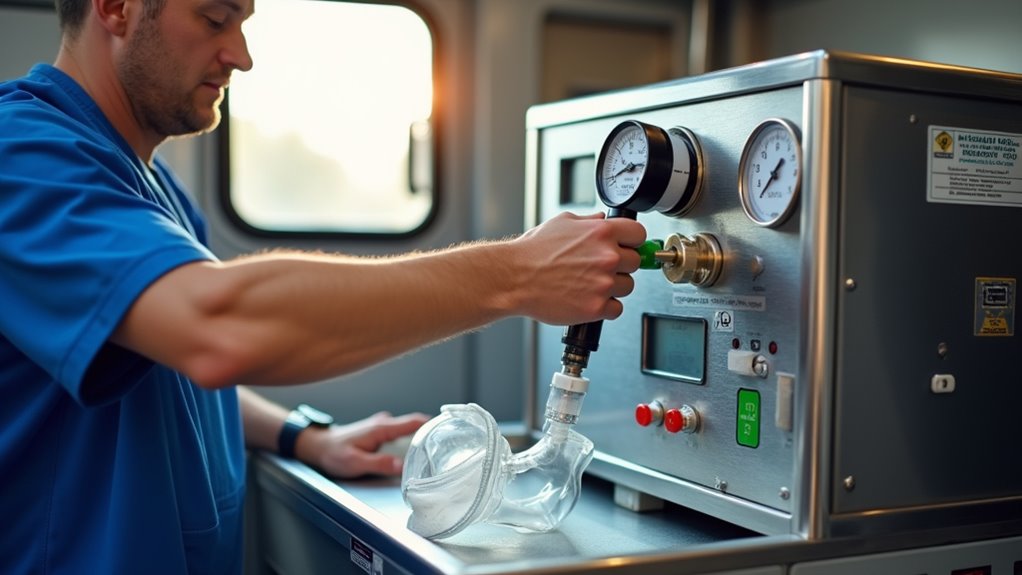Medics administer nitrous oxide in the field using portable N₂O/O₂ delivery systems with demand-flow regulators and scavenging equipment. You’ll find they maintain a minimum 30% oxygen ratio, typically using preset 50/50 or 70/30 N₂O-oxygen mixtures. Patients self-administer through masks or mouthpieces while remaining conscious, with effects occurring within minutes. Proper setup requires securing cylinders, calibrating flow rates, and monitoring ventilation. Understanding the complete protocol guarantees ideal therapeutic results.
What Makes Nitrous Oxide Effective for Field Use

While many sedation options exist for field medical care, nitrous oxide stands out as an exceptionally practical choice due to its unique combination of rapid action, safety, and operational efficiency.
The gas delivers calming effects within minutes of patient exposure. You’ll find its superior pain relief profile particularly valuable in field settings, where you need to act quickly and effectively. Through its mechanism of NMDA receptor inhibition, nitrous oxide provides effective analgesia for patients. The gas works within minutes through simple mask administration, and patients remain conscious and responsive throughout the procedure. When you stop delivery, the effects wear off almost immediately, presenting a reduced risk of complications compared to other sedatives. The combination of oxygen and nitrous provides optimal safety while maintaining the desired calming effects.
The portable equipment and straightforward administration make it ideal for mobile medical teams. You won’t need IV access or complex monitoring systems, and patients can typically resume normal activities shortly after treatment, eliminating the need for extended recovery periods.
Required Equipment and Setup Protocol

Medical personnel must store your portable N₂O/O₂ system upright in a secure, temperature-controlled environment, with clear access to both the main unit and backup cylinders.
Your delivery system’s core components include demand-flow regulators, scavenging equipment, and interchangeable patient interfaces that you’ll need to inspect before each use. This setup provides a convenient and accessible pain management solution for emergency responders in the field. The system features a preset mixture that delivers 50% nitrous oxide and 50% oxygen for safe analgesia. Patient safety is enhanced through a hand-held valve that allows for self-administration.
You’ll find that proper setup requires connecting the N₂O and O₂ supplies, calibrating the fixed 50/50 mixture, and testing the automated safety features including the O₂ deprivation shutdown and alarm systems.
Equipment Storage Guidelines
Safe storage of nitrous oxide equipment requires strict adherence to facility design and maintenance protocols. You’ll need to maintain storage facilities with 1-hour fire-rated construction and guarantee temperatures stay between 32-125°F. Your storage facility inspection procedures must include regular checks of cylinder weights, leak detection, and proper ventilation systems. Since nitrous oxide is an oxidizing gas, proper segregation from flammable materials is essential. The facility must include proper labeling of all cylinders to prevent misidentification and ensure safe handling.
Store cylinders upright in secure racks or anchored positions, and separate full cylinders from used ones in clearly labeled sections. You’ll need to implement cylinder retirement documentation when weights reach predetermined thresholds. The well-ventilated area must be maintained to ensure safe gas dispersal.
For exterior storage, protect equipment from moisture and extreme temperatures using moisture-resistant surfaces and proper enclosures. Keep detailed maintenance logs of all inspections, rotations, and audits to comply with controlled substance protocols. Ensure storage areas exclude non-compatible systems to minimize fire risks.
Delivery System Components
A complete nitrous oxide delivery system requires several core components working in harmony to guarantee safe and effective administration. You’ll need to safeguard proper regulator maintenance and integration with the central distribution network for optimal performance. Medical professionals can choose from cabinet-mounted or wall-mounted units based on facility needs. The system must align with NFPA 99 standards to ensure patient safety and compliance. A dedicated loading indicator displays during system startup to confirm proper initialization.
| Component | Function |
|---|---|
| Flowmeters | Visual monitoring of gas flow with precise valve control |
| Mixing Systems | Blending N₂O with oxygen at 30-70% ratios |
| Demand Valves | Patient-controlled inhalation through masks/mouthpieces |
| Scavenging Units | Removal of exhaled gases for safety |
The system connects to either high-pressure cylinders (750 psi) or cryogenic storage tanks through copper piping. You’ll monitor gas concentrations via dedicated flowmeters while maintaining minimum 30% oxygen levels to prevent hypoxia. For patient comfort, scented masks are available, and leak-proof infrastructure ensures environmental safety throughout the delivery process.
Proper Gas Mixture Ratios and Safety Limits

Maintaining precise gas mixture ratios stands as the cornerstone of nitrous oxide administration, with standardized concentrations guaranteeing both efficacy and patient safety. You’ll need to maintain a minimum of 30% oxygen during delivery, with the ADA-recommended 70/30 N₂O-oxygen ratio being the gold standard for most procedures. Storage limitations and equipment inspection are vital for maintaining these precise ratios. Regular system maintenance checks help ensure the sustained accuracy of these critical gas ratios. The gas’s faint sweet odor helps technicians detect potential leaks during administration. Well-ventilated environments are essential during administration to minimize exposure risks for healthcare providers.
For safety compliance, you must ensure proper ventilation and scavenging systems to keep occupational exposure below the NIOSH-recommended 25 ppm limit. You’ll find preset delivery devices that provide fixed ratios, typically 50/50 or 70/30 mixtures. It’s imperative to verify that your delivery system isn’t compromised, as proper ratios prevent hypoxemia while delivering effective sedation for procedures.
Patient Assessment Before Administration
Before administering nitrous oxide, medical personnel must conduct a thorough patient assessment that encompasses five critical domains: respiratory capability, baseline essential signs, contraindications screening, clinical indication validation, and detailed medical history.
Following a careful screening protocol, you’ll need to confirm the patient’s oxygen saturation is ≥90% and assess their ability to self-administer through a nasal mask. A patient medical history review must rule out chronic respiratory conditions, recent trauma, and potential contraindications.
Check cognitive function and alertness to guarantee proper mask operation
Document baseline essential signs including blood pressure and respiratory rate
Evaluate pain severity and procedural anxiety levels
Screen for recent substance use and relevant allergies
This systematic assessment helps safeguard safe administration while maximizing therapeutic benefits.
Step-by-Step Administration Process
You’ll begin by assembling your portable nitrous oxide delivery system and connecting it to a properly fitted nasal mask, guaranteeing all connections are secure and the gas mixture control is set to 100% oxygen.
Next, you’ll confirm your monitoring equipment is operational, including pulse oximetry and respiratory rate sensors, positioning them for continuous patient assessment throughout the procedure.
As you initiate gas flow, you’ll maintain strict documentation of concentration changes while observing the patient’s response to verify safe and effective administration.
Equipment Setup and Assembly
The proper setup and assembly of nitrous oxide equipment requires a systematic approach to guarantee safe administration in the field. Equipment maintenance procedures must begin with thorough cylinder level verification and circuit integrity checks.
Personnel training protocols emphasize the importance of connecting the N₂O cylinder and O₂ supply to the Nitronox unit with precise attention to safety mechanisms.
- Attach the bacterial-filtered disposable circuit to the fresh gas outlet, ensuring the reservoir bag is properly positioned
- Verify all safety features, including the oxygen-driven pressure control and scavenging system
- Test the audible alarm system and confirm proper calibration of flowmeters
- Connect and secure the appropriate patient interface (facemask or mouthpiece) while maintaining scavenging efficiency
Before initiating gas flow, you’ll need to confirm that emergency backup systems are functional and readily accessible, including the 100% oxygen backup and manual air valve systems.
Monitoring During Gas Delivery
Once equipment setup is complete, proper monitoring during nitrous oxide delivery becomes the primary focus of medical personnel. You’ll need to maintain regulatory compliance guidelines by continuously monitoring gas levels using infrared analyzers and ensuring they stay below the NIOSH-mandated 25 ppm TWA limit. Workplace safety considerations require you to check capture velocities and maintain proper exhaust flow rates.
| Monitoring Task | Critical Threshold | Action Required |
|---|---|---|
| Gas Analysis | 25 ppm TWA | Verify scavenging |
| Capture Velocity | 250 cfm | Adjust hood position |
| Exposure Level | 150 ppm | Immediate intervention |
During administration, you must track both patient response and environmental readings. Use diffusive sampler badges in breathing zones while maintaining detailed logs of measurements. If readings exceed 150 ppm, immediately adjust masks and verify scavenger system functionality.
Monitoring Vital Signs During Treatment
Monitoring essential signs effectively during nitrous oxide administration requires systematic assessment of multiple physiological parameters. You’ll need to track respiratory rate trends and safeguard pulse oximetry accuracy throughout the procedure. Check critical signs every 5 minutes to maintain patient safety and document any deviations from baseline measurements.
Monitor oxygen saturation continuously via pulse oximetry, discontinuing treatment if SpO₂ drops ≥2% from baseline. Assess sedation levels using the Ramsay Sedation Scale to classify consciousness states. Track blood pressure, heart rate, and respiratory patterns at regular intervals. Use waveform capnography through a nasal cannula to evaluate breathing effectiveness.
Early detection of critical sign changes helps prevent complications and confirms appropriate intervention. Remember to document all measurements, including pre-administration baselines and post-treatment values, in the patient care report.
Recognizing Signs of Successful Administration
Successful nitrous oxide administration manifests through several key clinical indicators that you’ll need to recognize and document. While monitoring device efficacy, you’ll observe maintained consciousness levels with preserved verbal responsiveness and stable oxygen saturation. Your assessment should confirm pain reduction without compromising airway protection, minimizing administration risks through continuous observation.
| Clinical Sign | What to Monitor | Expected Outcome |
|---|---|---|
| Pain Control | Facial tension, agitation | Visible relaxation |
| Consciousness | Verbal responses | Alert, cooperative |
| Oxygenation | SpO₂, breathing pattern | ≥ baseline – 2% |
| Recovery | Post-procedure status | Quick return to baseline |
You’ll need to verify patient engagement through willing participation and coherent responses while maintaining appropriate sedation levels. Watch for the absence of adverse reactions like nausea or respiratory depression, ensuring rapid recovery after discontinuation.
Managing Potential Complications
Vigilantly managing nitrous oxide complications requires your immediate recognition and response to emerging symptoms across respiratory, neurological, and metabolic domains. Through thorough patient screening, you’ll identify at-risk individuals, particularly those with respiratory conditions or B12 deficiency. Understanding common misuse patterns helps prevent adverse outcomes during administration.
Monitor for hypoxia symptoms including dizziness, headache, or shivering immediately supplement with oxygen if detected. Assess for peripheral neuropathy signs, especially in patients with pre-existing B12 deficiency. Document any cognitive changes or hallucinations that may indicate neurological complications. Implement rapid intervention protocols when encountering respiratory distress, including immediate cessation and oxygen therapy.
Regular assessment of these indicators guarantees patient safety and allows for swift corrective action when complications arise. Your careful monitoring prevents progression to severe adverse events.
Post-Treatment Recovery Guidelines
After completing nitrous oxide administration, your primary focus shifts to implementing a structured recovery protocol that encompasses essential post-treatment care. You’ll need to administer 100% oxygen for 35 minutes while continuously monitoring the patient’s respiratory status and consciousness level.
For fluid management, you’ll adjust IV rates based on blood pressure readings 1,000 mL/hour for adults with BP below 80 mmHg, or 150-200 mL/hour when systolic exceeds 90 mmHg.
Your patient readiness assessment must confirm stable cardiovascular and respiratory function before discharge. Post-treatment follow-up care includes a specific vitamin B12 supplementation schedule: daily 1mg IM injections for two weeks, followed by weekly doses for four weeks, then monthly maintenance.
You’ll document all treatment details, including flow rates, oxygen administration, and discharge conditions.
Emergency Response and Discontinuation Procedures
Safety stop signals and rapid response protocols are essential components of field-based nitrous oxide administration. You’ll need to recognize key indicators that require immediate discontinuation, including patient unresponsiveness, oxygen desaturation below 94%, or signs of paradoxical agitation.
Your emergency response must include immediate termination of N2O flow, administration of 100% oxygen, and activation of your organization’s emergency medical protocols when warranted.
Safety Stop Signals
Medical personnel must recognize and respond to critical stop signals when administering nitrous oxide in field conditions. Key safety indicators include neurological changes, respiratory depression, and cardiovascular irregularities that serve as immediate discontinuation triggers. You’ll need to monitor crucial signs continuously and remain alert for sudden alterations in patient status.
Watch for signs of disorientation, tingling sensations, or other neurological symptoms that may indicate toxicity. Monitor respiratory reflexes and initiate airway management if depression occurs. Track cardiac output and blood pressure for sympathetic response variations. Observe for nausea, vomiting, or other adverse reactions requiring antiemetic intervention.
If you detect any of these signals, immediately terminate nitrous oxide flow, administer 100% oxygen, and implement appropriate emergency protocols based on the specific complication present.
Rapid Response Protocols
When administering nitrous oxide in field conditions, rapid response protocols require systematic attention to both preventive monitoring and emergency interventions. You’ll need to maintain continuous capnography and SpO2 monitoring while documenting vital signs in real-time.
If SpO2 drops ≥2% from baseline, you must immediately discontinue N2O administration and shift to 100% oxygen delivery. Don’t restart N2O even if saturation improves. Instead, switch to alternative pain management methods.
Staff training and policy development should emphasize proper equipment inspection, including checking cylinder pressures and maintaining clean reduction valves.
You’ll need to monitor the patient for 15-30 minutes post-procedure, evaluating the potential need for advanced airway support. Keep emergency oxygen supplies readily available and guarantee your scavenging systems are functioning correctly to remove waste gas.
Frequently Asked Questions
How Long Can a Single Nitrous Oxide Tank Last in Field Conditions?
Your estimated tank duration depends heavily on usage patterns and cylinder size. A standard E-size cylinder at 50/50 mixture typically lasts 45-60 minutes of continuous use, while an H-size cylinder can provide 2-3 hours.
You’ll boost longevity by maintaining ideal storage temperatures between 10-25°C. However, you must factor in your patient throughput and procedure duration, as these variables substantially impact consumption rates.
What Temperature Ranges Affect Nitrous Oxide’s Stability During Storage and Transport?
You’ll need to maintain proper storage temperatures between 0°F-10°F (-18°C to -13°C) for refrigerated liquid N2O in North America, or -20°C to -13°C in Europe.
For ideal transport conditions, keep pressurized cylinders below 21°C (70°F) at 5070 kPa (735 psi). You must avoid temperatures exceeding 300°C, which can trigger decomposition.
Always store cylinders in cool, dry environments and protect them from direct sunlight to maintain stability.
Can Nitrous Oxide Be Safely Administered During Patient Transport in Moving Vehicles?
Yes, you can safely administer nitrous oxide during patient transport, but you’ll need to follow strict protocols. You must guarantee secure patient restraint to prevent movement-related complications and maintain careful dose monitoring throughout transit.
You’ll require two qualified medical personnel, continuous critical sign monitoring, and properly secured gas cylinders. Your transport vehicle must be equipped with specialized mounting systems and monitoring equipment to maintain safe administration standards.
How Frequently Should Field Personnel Undergo Retraining for Nitrous Oxide Administration?
You’ll need to complete formal retraining annually, though your organization may require more frequent proficiency monitoring if you’re working in dynamic field environments.
Plan to undergo continuing education whenever protocols change or after any adverse events. You must demonstrate both theoretical knowledge and hands-on competency during assessments.
Don’t skip scenario-based training sessions, as they’re essential for maintaining emergency response skills and ensuring safe administration practices.
What Backup Methods Are Recommended if Nitrous Oxide Equipment Malfunctions Mid-Procedure?
If your nitrous oxide equipment malfunctions, you’ll need to immediately switch to your backup oxygen supply and assess the patient’s oxygenation status. You should then implement alternate pain management methods, including systemic analgesics like opioids if appropriate.
You’ll want to document the equipment failure and move your patient to non-pharmacological interventions such as positioning or immobilization. Remember to maintain continuous important sign monitoring throughout the change.

